07/31/2012. Remarks by Johan Visschedijk: "Shortly after completing the basic engineering work on the AD (later A-1) Skyraider, Edward Heinemann's design team at Douglas in El Segundo, California, USA, set forth to find ways of enlarging and improving upon the basic design. In 1949-1950, it was not yet clear that turbojet engines could satisfy USN take off and endurance requirements for carrier-based aircraft, so, after reviewing various options, Heinemann's team selected the Allison T40 turboprop engine and an Aeroproducts propeller for their new design, the XA2D-1 Skyshark.
A Douglas press release announced the May 26, 1950 first flight of the prototype XA2D-1 (BuNo. 122988) but failed to explain that test pilot George Jansen's maiden voyage had been repeatedly delayed by problems with the engine and its link-up to the plane's six-blade, contra-rotating propeller. The Skyshark was to undergo rigorous testing over the next four years – its lease on life almost certainly lengthened by the June 1950 outbreak of the Korean War – but problems with the Skyshark's power plant were never solved with the result that the Skyshark itself was relegated to 'limited edition' status rather than joining the Fleet.
It was a big aircraft in every respect, being 41 ft 2.4 in (12.56 m) long, with a wingspan of 50 ft 0.2 in (15.25 m). With the XT40-A-6 power plant delivering 5,332 bhp, the XA2D-1 had an empty weight of 18,720 lb (8,370 kg) and a gross weight of 22,966 lb (10,417 kg). The aircraft was flown to a maximum speed of 467 mph (752 kmh), and combat ceiling was listed as 40,600 ft (12,375 m). The aircraft was intended from the beginning to be a work-horse and could carry an ordnance load comprising one 2,000 lb (907 kg) bomb, eight 5.0 in (127 mm) high-velocity aircraft rockets (HVARs) and four 0.787 in (20 mm) cannon.
At one time, it seemed that the Skyshark was destined to become the principal medium attack air-craft aboard the USN's Essex class carriers which, at this juncture, did not yet have the British-developed angled decks introduced in 1951 aboard USS Antietam. After the number two aircraft (BuNo. 122989) was introduced with redesigned engine exhausts, the USN placed a June 30, 1950 order (five days into the Korean conflict) for ten production Skysharks (BuNos. 125479 to 125488). This was followed almost immediately by an August 14, 1950 order for 81 A2D-1s (127962 to 128042) and then by a February 10, 1951 order for 250 (132793 to 133042).
As things turned out, it is thought that the seventh production A2D-1 (BuNo. 125485) was the final Skyshark to be flown while a further four airframes were completed but never went aloft. Long after the USN rushed the big craft into production, problems with the power plant lingered and various proposed solutions failed to 'fix' the problem. As time went on – by December 1950 the Sabre and the MiG had 'met over the Yalu River – it became increasingly apparent that turboprop power was not a practical substitute for the pure jet engine.
Mishaps dogged the Skyshark program. In November 1950, Lieutenant Commander Hugh Wood was killed in a belly crash-landing of the prototype at Edwards AFB while in August 1954, George Jansen encountered mid-air difficulties while flying 125480 and had to eject. Jansen sustained a serious back injury and spent several months in a plaster cast. It was this incident, rather like the straw that broke the camel's back, which caused the USN to cancel all pending orders for the type.
Ironically, although it was the arrival of the jet age which doomed the Skyshark, its propeller-driven stablemate, the Skyraider, enjoyed a long and successful career and remained in service as the USN's principal medium attack aircraft until about mid-1965 when it began to give way to the Grumman A-6A Intruder.
As for the Skyshark, most of the airframes that were built were eventually scrapped. One which did survive for a while was BuNo. 125485 which was used (minus its engine) for ground radar calibration at the Los Angeles International Airport. It was later given to Ed Maloney's Planes of Fame museum at Claremont, by 1981 it was in a derelict and vandalized condition at Chino. However, after 1993, the aircraft was trucked to the Idaho Falls Airport and was restored to display status by Pacific Fighters, where it still is as of this day."
